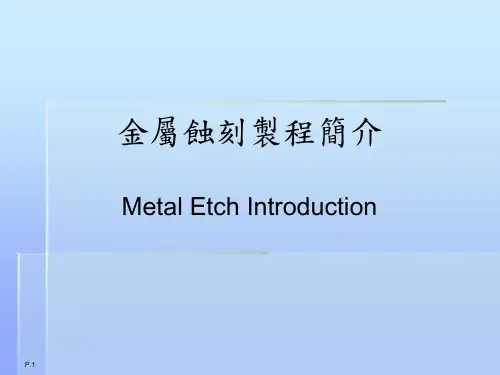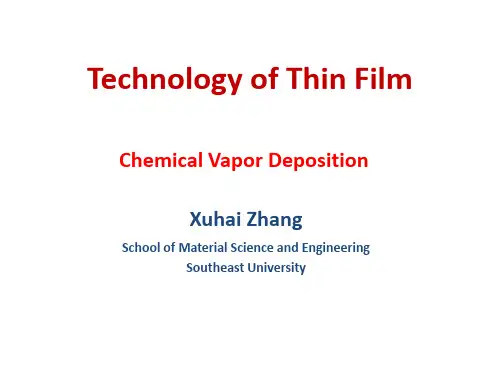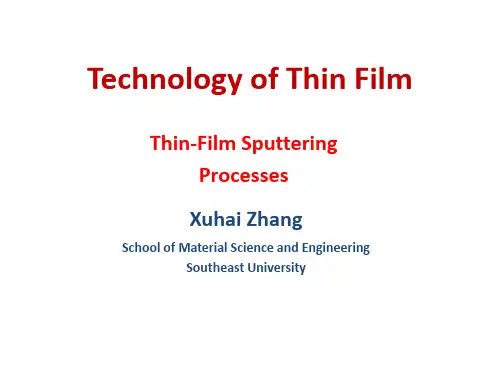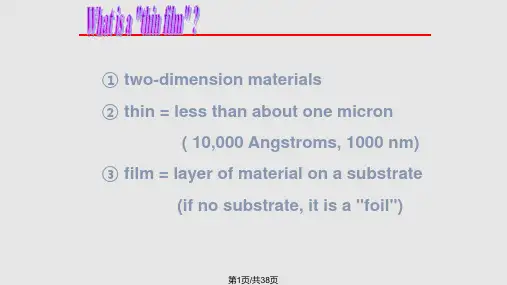薄膜技术英文课件:1introduction
- 格式:ppt
- 大小:8.18 MB
- 文档页数:54











英⽂版BOPP薄膜简介Biaxially Oriented Polypropylene Film (BOPP)Many of the unique characteristics of polypropylene enhance its utilization in the application of film. The main application for polypropylene film are the packaging of food, textiles and tobacco products. Biaxially Oriented Film (BOPP)Biaxial orientation is a process in which a continuous cast film is heated to bring it to a stretchable temperature and thereafter it is stretched in machine and then in transverse direction.Biaxial orientation of polypropylene (BOPP) film is done by two methodsTenter frame processDouble bubble processTenter Frame ProcessTenter frame process is a very expensive way of processing BOPP film. However it has become popular due to higher production rate with very thin and wide width film (Fig. 1)ExtrudersExtruders with 150 to 200 mm dia screws having L/D of 26:1 to 30:1 are more popular.Dies600 to 1500 mm wide coat hanger type of dies are usedThe Tenter Frame ProcessCasting & QuenchingThe molten polymer extruded from the die is placed against a chill roll or multiple chill rolls. The most popular being casting onto a chill roll partially submerged in a water bath. The chill roll and water bath temperatures are generally 20 to 25°C. Usually, these chill rolls are 1000 to 2000 mm in diameter and approximately 1000 to 1500 mm wide. The surface of the chill roll must be very smooth; pitting or irregularities on the surface of the roller will influence the film quality. An air knife is used to force proper contact of molten polymer against the casting roll. The cooled web proceeds towards the machine direction orientation section.Machine Direction Orientation (MDO)The base sheet is alternatively heated by passing it over the heated rollers (145 - 150°C) to achieve uniform heating of web throughout its thickness. These rollers are usually smaller in diameter (450 to 600mm) compared to the casting drums (chilled rolls).When the film reaches the necessary stretching temperature, it is passed over a series of stretching rolls which are usually arranged in pairs. Each pair has a rubber nip roll to prevent slipping of the web while stretching. These first set of nip rollers are run at a speed similar to preheat rollers. The next set of rollers are operated at higher speeds than the first set of nip rollers. Usually the stretch ratio is kept between 4:1 to 6:1.From the stretching rollers, the film is passed on to a series of annealing rollers, which are heated to a temperature, adequate to prevent shrinkage in the machine direction (MD) of the web. Transverse Direction Orientation (TDO)From the machine direction orienter, the film is guided on to the chain (Fig. 3), containing clips (Fig. 4) which close on to the film. A rail guides the chain with clips to preheating section, where the film is heated with hot air at 160°C, slightly below the melting point of polypropylene.As the film leaves the preheat section of the oven, the chain diverges quite rapidly to a ratio of 8:1 to 10:1. The film is then passed on to annealing oven where it is maintained at 155°C, to reduce the shrinkage of the film. Usually the tenter frame run at line speeds of 200 to 300 meters/min.WindingEdges of the film remain thick, as they are in the clips while the film is being stetched. These edges are then trimmed off as the film leaves the tenter frame. The wide film is slit into the required width by rotating knives and wound on to separate winders.Double Bubble ProcessThe equipment for this process is small compared to that of tenter frame process (Fig. 5). It is difficult to produce thin film in double bubble process. The output in term of quantity and width of the film is also very low compared to that in tenter frame.ExtrudersGenerally 50 mm to 75 mm extruders are usedDiesCircular dies of 150 to 200 mm diameters are more popularQuenchingThe extruded tube from the die is directly taken into the quenching bath (20-25°C) collapsed between the nip rollers located at the bottom of the quench bath. The film is then taken up to second set of nip rollers via a drying unit. The water is stripped in the drying unit.PreheatingThe tube in its flattened state is heated (at 150 to 160°C) either by IR heaters or hot air. The heated tube is inflated to its new dimensions, which is usually 5 to 6 times its original diameter. With the third set of nip rollers, the film is stretched in the machine direction at the ratio of 5:1 to 6:1A set of cooling rings are used to cool the inflated bubble prior to being collapsed. Collapsed tube is slit on both the edges and the web is then separated before winding.Effect of Processing Variables on Film PropertiesFilm properties depend on different processing variables, as described below1.Requirement: A :High modulus and tensile strengthB :Low shrinkageA Tensile strength and Modulus can be improved by :-Lowering the temperatures of chill roll and quench water-Increasing the stretch roll temperature-Increasing the line speed-Increasing the stretch ratiosB Lower shrinkage can be achieved by :-Using higher stretching temperature-Using higher annealing temperatureII Requirements : A :Low HazeB :High GlossA Haze can be reduced by-Lowering temperature of chill roll and quench water-Increasing the temperatures of stretching and annealingB Gloss can be improved by-Using higher melt temperature-Using chill roll, MD rolls and die having clean and smooth surfacesRepol Polypropylene Grades for BOPP FilmRepol Grade MFICharacteristics(g/10min)HOMOPOLYMERH029SG 2.9Good processability andlow gelsRANDOM COPOLYMERR070EY7.0Contains antiblock andslip. Low heat sealtemperaturesApplications of BOPP FilmsFollowing are the important features of BOPP film which make it a material of choice for flexible packaging :Low specific gravity which results in higher yield (m2/kg)Higher mechanical properties, which allow for thinner films to be madeBOPP films have by far the highest moisture barrier of all plastic films. WVRT values at 38°C and 98% RH of different film substrates are as follows :20 microns OPP- 4.85 gms/sq.m/24 hrs20 microns HDPE- 6.25 gms/sq.m/24 hrs25 micron Cast PP-10.00 gms/sq.m/24 hrs25 micron LDPE-15.00 - 20.00 gms/sq.m/24 hrs10 micron PET-45.00 gms/sq.m/24 hrsBOPP films have good barrier to flavours and aromas, particularly at the levels of concentration normally encountered in packaged products.Co-extruded BOPP film with good barrier and high transparency is heat sealable as produced i.e. without having to be coated, avoiding additional operation. The other major advantage is, being heat sealable on both surfaces, it is possible to seal particularly on VFFS operations with better seal integrity and a much neater pack.?BOPP films have outstanding optical properties and thegloss/transparency/sparkle obtained are among the best available on any material.BOPP films have extremely high strength - particularly tensile strength, puncture resistance, bursting strength, stiffness, tear strength and abrasion resistance.BOPP film packages also have a very crisp feel which make them definitely superior to those made from flexible materials.BOPP films have very high stability / performance over a very wide range of temperatures and environmental conditions. They are not susceptible to high relative humidity like cellophane and hence retain their properties and dimensional stability over the entire range of conditions normally encountered by packages.BOPP films have very high chemical resistance to fats/oils - particularly of vegetable origin, most chemicals and many solvents. The basic material (polypropylene) is essentially a highly compatible with most packaged products. It is particularly suitable for direct food contact.BOPP films have extremely high flex crack resistance. Polypropylene is the only basic resin that has an "integral hinge" property, in that it can be flexed any number of times without fracture. This property is extremely important in flexible pouches during their transit and handling.BOPP films are eminently suitable for down stream operations. They are highly amenable to all operations like printing, coating, lamination, metallisation and pouching.BOPP film can be subjected to sterilization without impairing mechanical properties and hence has wider packaging applications.BOPP film is heat sealable at high speeds using co-ex OPP or off-line coated film Due to the higher stiffness of BOPP film, higher packaging speeds (50-60 m/min) are possibleBOPP films can be vacuum metallised with high purity aluminium, to significantly enhance barrier propertiesSome of the typical applications of BOPP film are as follows :(A)Plain filmIndustrial tape (25-40 mic)Pressure sensitive tapesLamination (10-20 mic)Book covers, brochures, catalogues, shopping bags, carton boxes, cosmetic boxes, restaurant menus, film to film laminates (PET/BOPP/POLY)Food packing (20-40 mic)Laminates, metallizingOthers (12-40 mic)Tea chest lining, flower over-wrapping, textiles, cable over-wrappings, photo albums, release film, biscuit inner-wraps, envelope windows, tear tapes,metallizing, stationery(B)Co-Extruded filmOver wrapping (18-23 mic)Cigarette, audio/video cassette boxes, cartons, blades, toffees and candiesGeneral purpose (20-40 mic)Lamination, snack food, bakeries, cosmetic, noodles, textiles, bread, audio/video cassette, metallizing, twistwrapFood packing (20-50 mic)Lamination, food, chipsSuper Seal (25-35 mic)Powdery material, food grain, sugarBOPP FilmTrouble Shooting GuideTenter frameDefect Source SolutionThickness variation-Adjust the die gap-Adjust die heat temperatures-Check screen pack or filter, change ifnecessary-Check air knife position-Look for air bubbles under the sheetMDO-Increase temperature of preheat rolls-Decrease gap between stretching rolls-Decrease speed of MDO rollsTDO-Adjust stretching section temperatures-Examine oven for foreign objects blockinghot air nozzlesExtruder Surging -Check melt temperature fluctuation and pressure fluctuations-Increase back pressure by lowering metering section temperatures-Increase first transition zone temperatureSplits Foreignparticles in theresin -Examine for gels or dirt-Discontinue putting reclaim or repelletized pellets in main feed-Change filter packOvens-Raise temperature of the preheat section ofovenWater in theresin-Change resin feedGauge Band-Find source of gauge variation and fix Jerky chain-Lubricate rail and chainOil drops on film in oven -Decrease oil flow to chain and rail and wipe off excess oilDirty clips-Wind base sheet on MDO winder andcheck chain-Clean clips or remove faulty clip andreplaceHaze bandsfrom MDO-Increase stretching heat of MDONon uniformmelt-Adjust extruder heat profilePoor optics High Haze Low GlossMDO Heats-Increase temperature of preheat rolls andstretching rolls if haze bands are present Low extrusionheats-Raise melt temperatureSlow cooling incasting section-Decrease casting drum temperature-Decrease bath temperatureWater marks Water carry-over to MDOsection-Remove water from web before MDOBubbles or Voids Resin airentrapment -Change resin-Increase the transition zone temperature -Increase the back pressure BOPP FilmTrouble Shooting GuideDouble Bubble frameDefect Source Solution Thickness variation Die : poor flow-Adjust the die gap -Adjust the die temperaturesPolymer filter unplugged -Check screen pack or filter, change if necessary Unlevel water-Adjust level of water ring or bathAir draft onbubble-Seal air leaks in enclosure around bubble Blow-outs or BubblebreaksOven-Oven heats too low, raise temperatureGels in film-Change filter-Change resinPlate-Out marks from mandrel -Wipe off mandrel-Lower melt temperature -Raise mandrel temperature -Change resins。